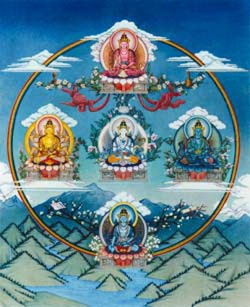The Tree of Enlightenment: An Introduction to the Major Traditions of Buddhism - Chapter Eighteen: The Philosophy of the Middle Way
The Tree of Enlightenment
An Introduction to the Major Traditions of Buddhism
Peter Della Santina
Chapter Eighteen
The Philosophy of the Middle Way
The philosophy of the Middle Way, or Madhyamaka philosophy, has sometimes been called the central philosophy of the Mahayana tradition. It has even been called the central philosophy of Buddhism in general. This alone is sufficient to give us some idea of its importance. The Madhyamaka philosophy has also been called the doctrine of emptiness (shunyata) and the doctrine of the non-self-existence, or insubstantiality, of things (nihsvabhavavada).
The founder of this philosophy was the great holy man and scholar, Nagarjuna, who lived between the end of the first and the beginning of the second century of the common era. He was born in the south of India, of Brahmin parents. Biographers, however, tell us that he was an early convert to Buddhism. Nagarjuna was an interpreter more than an innovator. He took certain inspirations and insights from the sutras and the Abhidharma, reinterpreting and restating them in a particularly clear and forthright way. He is noted for his substantial literary works, which include not only philosophical works, like the Foundation Stanzas of the Middle Way (Mulamadhyamakakarika) and the Seventy Stanzas on Emptiness (Shunyatasaptati), but also works on logic, the practices of the Bodhisattva, fundamentals of Buddhism, and even works of a devotional character, such as four works extolling the virtues of qualities like the perfection of wisdom. Nagarjuna's efforts in promoting and propagating the central ideas of the Mahayana won him widespread recognition as a Bodhisattva not only in India but also in Tibet, China, and Japan. He figures prominently among the primary founders of the Tibetan, and Ch'an, and Zen Buddhist traditions.
The works of Nagarjuna--and, indeed, the teaching of the Madhyamaka philosophy--should not be seen as a radical departure from the general direction and development of Buddhist thought as a whole. They had definite origins in the teachings of the Buddha and in the early Buddhist tradition, particularly the Abhidharma. In the Theravada canon, there is a record of the Buddha's statements about the importance of emptiness (shunyata) and also a record of the famous 'fourteen inexpressibles,' or unanswerable questions. In addition, we find a very clear precursor of the Madhyamaka philosophy in the Perfection of Wisdom literature, where the primary theme is emptiness. This is the very theme elaborated by Nagarjuna in works like his Mulamadhyamakakarika. In the Abhidharma Pitaka, in the Book of Causal Relations (Patthana), too, we can see the anticipation of the Madhyamaka philosophy in the emphasis on the examination of relations. All these are clear indications of the very early and authentic origins of the Madhyamaka philosophy.
Just as the contents of the Madhyamaka philosophy are not anything radically new, so the method of the Madhyamaka is not, but can be found in the very earliest period of the Buddhist tradition. The characteristic method of the Madhyamaka is analysis--the analysis of phenomena and of relations. One might even say that its characteristic method is not only analysis but also critical dialectic. All this methodology--from analysis to criticism and dialectic--is, like the substance of the Madhyamaka, indicated both in the Buddha's own approach in his discourses, the sutras, and in the approach of the Abhidharma tradition, where we find the various alternatives isolated and methods of answering questions elucidated. This should be sufficient to indicate that the origins and methods of the Madhyamaka philosophy go far back in the history of Buddhist thought.
As for Nagarjuna's fundamental message in his philosophical works, it is important first to realize the object toward which his criticism is directed--namely, the notion of independent being, or self-existence (svabhava). The fact that his doctrine has been termed the doctrine of insubstantiality (nihsvabhavavada, literally, 'the doctrine that refutes svabhava') emphasizes Nagarjuna's characteristic rejection of the notion of self-existence.
Nagarjuna rejects self-existence by examining relativity, or interdependent origination, in a critical, dialectic way, beginning with the idea of self-existence, going on to the idea of relativity or the absence of self-existence, and terminating with the idea of emptiness (shunyata). These three steps--from self-existence to non-self-existence, and finally to emptiness--are developed through three types of investigation: (1) the investigation of causality, (2) the investigation of concepts, and (3) the investigation of knowledge. Through the investigation of these three classes of phenomena, Nagarjuna and the Madhyamaka system take us from the naive, everyday belief in the idea of self-existence, in the independent reality of phenomena, to an intellectual understanding of emptiness.
Let us first look at the Madhyamaka critique of causality. Madhyamaka philosophy arrives at the insubstantiality and relativity of all phenomena through an examination of interdependent origination. In this context it is shown that, insofar as all things exist dependent on a combination of causes and conditions, they have no independent self-existence and are therefore empty. The classical example is that of the sprout, which exists dependent on the seed, earth, water, air, and sunlight. Inasmuch as the sprout depends on these factors for its existence, it has no self-existence and is therefore without self-existence. And being without self-existence, it is empty. This is the simplest and most direct Madhyamaka investigation of causality, and it leads us straight to the notion of emptiness.
But for the Madhyamaka, emptiness also means non-origination, non-production. In the Perfection of Wisdom literature, as we saw in the Heart Sutra, the idea of non-origination and non-cessation occurs very frequently. Here, too, in the Madhyamaka philosophy, emptiness means non-origination--the non-arising in reality of all phenomena. Nagarjuna explains this particular consequence of emptiness through the dialectic method. Here we see again the fourfold dialectical analysis that appeared in the fourteen inexpressible propositions which the Buddha rejected.
There are four possibilities for the origination of phenomena, or the relationship between cause and effect: (a) that the cause and effect are identical, (b) that the cause and effect are different, (c) that the cause and effect are both identical and different, and (d) that phenomena arise without cause. These four basic alternatives are indicated in the first verse of the Mulamadhyamakakarika, which states that 'No entity is produced at any time, anywhere, or in any manner from self, from other, from both, or without cause.' This is the fundamental Madhyamaka critique of causality.
It is interesting to note that these four alternatives are analytically derived. Otherwise, one might wonder how it is that we isolate only these four. The Madhyamaka isolates these four in the following way: If phenomena do originate, they will originate either with a cause or without a cause. Here we already have two fundamental alternatives: phenomena originate either with or without a cause. The latter position is represented in the fourth alternative, according to which phenomena originate without a cause. Now, if we accept that phenomena do originate with a cause, then the effect and the cause can either be identical or different. In this way, we isolate the first two of the four alternatives: the identity of cause and effect, and the difference of cause and effect. The third alternative--that the cause and effect are both identical and different--is simply a combination of the first two. In this way, we analytically arrive at the four alternatives, each of which is, in turn, to be rejected.
Each of these four explanations of the nature of causality was represented by a philosophical school contemporary with the Madhyamaka. The position that maintains that cause and effect are identical was advocated by the Sankhya system, one of the classical systems of Indian philosophy. The position according to which cause and effect are different was propounded by the Hinayana schools of Buddhism, the Vaibhashikas and the Sautrantikas, and by some of the Brahmanical schools. The position according to which phenomena originate from causes that are both identical and different was affirmed by the Jaina philosophers. The last alternative, which holds that phenomena originate without a cause, was affirmed by the materialists in ancient India.
The Madhyamaka refutes these four explanations of origination by means of a very typical Madhyamaka method that has drawn the attention of many scholars both in the East and the West. This method is called the method of reductio ad absurdum, and it is a kind of negative dialectic that exposes the inherent contradictions and absurdities in the opponent's position. Let us try to illustrate how this method of argumentation works. Take the first alternative, which affirms the identity of cause and effect. The Madhyamaka says that, if in fact cause and effect are identical, then having bought cottonseed with the price one would pay for cloth, one ought to be able to clothe oneself with it. The idea that cause and effect are identical thus leads to absurdity. If cause and effect are identical, then there would be no difference between father and son, and also no difference between food and excrement.
In the case of the second alternative--that cause and effect are different--anything could originate from anything else, because all phenomena are equally different. Hence a stalk of rice might just as easily originate from a piece of coal as from a grain of rice, for there would be no connection between a stalk of rice and a grain of rice, and a piece of coal and a grain of rice would have the same relationship of difference to a stalk of rice. Thus the notion that cause and effect are absolutely different is an intrinsically absurd idea.
The third alternative--that cause and effect are both identical and different--is no more acceptable, and suffers from two faults. First, both the argument that refuted the identity of cause and effect and the argument that refuted the difference of cause and effect are applicable to the third alternative as well. The argument refuting the identity of cause and effect is applicable insofar as cause and effect are identical, and the argument refuting their difference is applicable insofar as cause and effect are different. We really have no new proposition in the case of the third alternative. Second, the third alternative is faulty because of the law of contradiction: no phenomenon can have contradictory characteristics. An entity cannot be both existent and nonexistent at once, just as one entity cannot be both red and not red at the same time.
Finally, the fourth alternative--the idea that phenomena originate without cause--is rejected by appeal to common experience. For instance, if we set a kettle of water on a lighted stove, the water will boil, but if we set it on a block of ice, it won't. Hence Madhyamaka philosophy concludes that causality according to any one of these four alternatives--from self, from other, from both, and without cause--is impossible. This is the Madhyamaka critique of causality.
There is also a Madhyamaka critique of concepts--the concepts of identity and difference, existence and nonexistence, and so forth. All these concepts are relative; they are mutually conditioning. Let us take the concepts of short and long. The ideas of short and long are relative one to the other. We say that A is shorter than B or that B is longer than C, so the concepts of long and short are relative. If I put two fingers side by side, we can say that one finger is longer than the other, but if I put out a single finger, unrelated to anything else, we cannot say anything about it being long or short. This is another kind of interdependence. Just as we have material dependence in the origin of a sprout that is dependent on a seed, the earth, sunlight, and so on, here we have conceptual dependence, the dependence of one concept on another.
And just as short and long are dependent one upon another, so identity and difference are dependent, or relative, to each other. Identity only has meaning in relation to difference, and difference only makes sense in relation to identity. The same is true of existence and nonexistence. Without the idea of existence, nonexistence has no meaning, and without nonexistence, existence has none. This is also true of the three divisions of time--past, present, and future. Depending on the past, the ideas of the present and future are conceived; depending on the past and future, we speak about the present; and depending on the present and the past, we speak about the future. The three moments of time--like short and long, identity and difference, and existence and nonexistence--are all concepts that are interdependent, relative, and empty.
Finally, the analysis of relativity is applied to knowledge, or to the means of acquiring knowledge. This is an important application of the Madhyamaka critique because ordinarily we accept the reality of phenomena on the basis of perception. For example, we say that this cup which I have before me undoubtedly exists because I perceive it--I can see and touch it. We have knowledge of things through the means of knowledge. Traditionally, in India, there were four means of knowledge: (i) perception, (ii) inference, (iii) testimony, and (iv) comparison.
For the sake of simplicity, let us take the case of perception. Suppose something is established by perception, that it is through perception that we accept the existence of the cup: What, then, is it that proves the existence (or truth) of the perception itself (i.e., the means of knowledge itself)? One might say that perception is proved by itself. In that case it would not require proof, but since when can something be accepted without proof?
Alternatively, one might say that perception is established or proved by other means of knowledge, but in that case we have an infinite regress, as in the old story of the philosopher who, when asked what the earth stood on, replied that it stood on a great tortoise, and when asked what the great tortoise stood on, said that it stood on four great elephants, and so on and so forth. Nowhere can we find a firm foundation for perception if perception is proved by other means of knowledge.
Finally, if perception is established by the object of perception, then perception and its object are mutually established and interdependent. This is, in fact, the case: The subject and object of perception are interdependent. They are mutually conditioned. Perception is therefore in no position to prove the existence of its object, and that object is in no position to prove the existence of perception, since they depend on each other. Thus knowledge--like cause and effect and mutually related concepts--is interdependent. It lacks self-existence, and is therefore empty. Nagarjuna composed a very interesting text, called The Turning Away of Objections (Vigrahavyavartani) which discusses this point.
Let us now consider some of the more practical, therapeutic applications of the Madhyamaka philosophy. The Madhyamaka uses the critical and dialectical method to reject the notions of cause and effect, mutually related concepts, and the subject and object of knowledge because these notions are the products of imagination, or discriminating thought (vikalpa). The Madhyamaka is concerned with dispelling these products of discriminating thought because they are the causes of suffering. It is as a result of discriminating the ideas of cause and effect, identity and difference, existence and nonexistence, and so forth that we are imprisoned in samsara. Discriminating thought, which has its seed in the mind, is the fundamental cause of suffering.
Nagarjuna says that, just as a painter, having painted the picture of a fearful demon, is then terrified by that image, so ignorant people, through discriminating thought, produce the cycle of the six realms of existence and then suffer as a consequence. Hence mind, which is afflicted by ignorance through the function of discriminating thought, produces the world we know, or samsara, where the concepts of causality, origination, cessation, and the rest have a meaning. This is the origin of suffering. And if samsara is the product of discriminating thought--if cause and effect, identity and difference, and existence and nonexistence are actually relative and empty--then there is no objective difference between samsara and nirvana.
What the renowned Mahayana and Madhyamaka doctrine of the non-differentiation of samsara and nirvana means is that the difference between samsara and nirvana is a subjective difference, a difference within one's own mind. It is not a difference in anything objective or real. Samsara and nirvana are the same thing seen from two different points of view: from the point of view of ignorance (of causality, identity and difference, existence and nonexistence), reality appears as samsara; from the point of view of insubstantiality, relativity, and emptiness, however, reality appears as nirvana.
Thus samsara and nirvana do not depend on anything 'out there': they depend, rather, on the point of view. It is in this context that the portrayal of nirvana emphasizes the fact that it is beyond existence and nonexistence, beyond origination and cessation, beyond all conceptions and expressions. Indeed, if nirvana is unconditioned, it must transcend these relative concepts. The two points of view--that of discriminating thought and ignorance, and that of insubstantiality, relativity, and emptiness--are reflected in the doctrine of the two truths, conventional and ultimate. The conventional truth is valid of this world in which ignorance prevails, in which we operate by accepting--and taking for granted--the ideas of cause and effect, identity and difference, existence and nonexistence, and the like. The ultimate truth is valid of this world seen in the light of insubstantiality, relativity, and emptiness. Like samsara and nirvana, the conventional truth and ultimate truth are not contradictory but complementary. They refer to two points of view--the ordinary, afflicted point of view obscured by ignorance, and the point of view of the enlightened ones.
Nagarjuna said that without relying on the conventional truth, the ultimate truth is not taught, and without arriving at the ultimate truth, nirvana is not achieved. In these few words, we can understand the complementary and necessary relationship between the two truths. We must rely on the conventional truth to communicate and function in the world, yet without arriving at an understanding of ultimate reality, or emptiness, nirvana is not gained. Hence we can see how groundless is the charge of nihilism leveled against the Madhyamaka by some of its opponents. Emptiness is not nothingness. The Madhyamaka does not teach the absolute nonexistence of cause and effect, or karma (wholesome and unwholesome actions with their consequences). All these exist on the conventional level. They exist as long as they are sustained by discriminating thought and ignorance. Without relying on the notion of cause and effect, or the doctrine of karma, the ultimate is not taught; yet without transcending causality, karma, concepts, and expressions, nirvana is not achieved.
Nagarjuna asserts that interdependent origination, emptiness, and the Middle Way are identical in significance. Taken from the point of view of ignorance, interdependent origination explains, sustains, and is the very essence of samsara. But interdependent origination is also emptiness, because everything that exists dependent on something else does not really exist--it has no independent being and does not exist by itself. Therefore, it is empty. All that is interdependent origination is also emptiness. And interdependent origination which avoids the alternatives of identity and difference, existence and nonexistence, eternalism and nihilism is also the Middle Way taught by the Buddha. Hence the system founded by Nagarjuna and sustained by his disciples and successors is known as the philosophy of the Middle Way, or Madhyamaka.
Continue Reading
Part One: The Fundamentals of Buddhism
- The Tree of Enlightenment: An Introduction to the Major Traditions of Buddhism - Chapter One: Buddhism: A Modern Perspective
- The Tree of Enlightenment: An Introduction to the Major Traditions of Buddhism - Chapter Two: The Pre-Buddhist Background
- The Tree of Enlightenment: An Introduction to the Major Traditions of Buddhism - Chapter Three: The Life of the Buddha
- The Tree of Enlightenment: An Introduction to the Major Traditions of Buddhism - Chapter Four: The Four Noble Truths
- The Tree of Enlightenment: An Introduction to the Major Traditions of Buddhism - Chapter Five: Morality
- The Tree of Enlightenment: An Introduction to the Major Traditions of Buddhism - Chapter Six: Mental Development
- The Tree of Enlightenment: An Introduction to the Major Traditions of Buddhism - Chapter Seven: Wisdom
- The Tree of Enlightenment: An Introduction to the Major Traditions of Buddhism - Chapter Eight: Karma
- The Tree of Enlightenment: An Introduction to the Major Traditions of Buddhism - Chapter Nine: Rebirth
- The Tree of Enlightenment: An Introduction to the Major Traditions of Buddhism - Chapter Ten: Interdependent Origination
- The Tree of Enlightenment: An Introduction to the Major Traditions of Buddhism - Chapter Eleven: The Three Universal Characteristics
- The Tree of Enlightenment: An Introduction to the Major Traditions of Buddhism - Chapter Twelve: The Five Aggregates
- The Tree of Enlightenment: An Introduction to the Major Traditions of Buddhism - Chapter Thirteen: The Fundamentals in Practice
Part Two: The Mahayana
- The Tree of Enlightenment: An Introduction to the Major Traditions of Buddhism - Chapter Fourteen: The Origins of the Mahayana Tradition
- The Tree of Enlightenment: An Introduction to the Major Traditions of Buddhism - Chapter Fifteen: The Lotus Sutra
- The Tree of Enlightenment: An Introduction to the Major Traditions of Buddhism - Chapter Sixteen: The Heart Sutra
- The Tree of Enlightenment: An Introduction to the Major Traditions of Buddhism - Chapter Seventeen: The Lankavatara Sutra
- The Tree of Enlightenment: An Introduction to the Major Traditions of Buddhism - Chapter Eighteen: The Philosophy of the Middle Way
- The Tree of Enlightenment: An Introduction to the Major Traditions of Buddhism - Chapter Nineteen: The Philosophy of Mind Only
- The Tree of Enlightenment: An Introduction to the Major Traditions of Buddhism - Chapter Twenty: The Development of Mahayana Philosophy
- The Tree of Enlightenment: An Introduction to the Major Traditions of Buddhism - Chapter Twenty-One: Mahayana Buddhism in Practice
- The Tree of Enlightenment: An Introduction to the Major Traditions of Buddhism - Chapter Twenty-Two: The Origins of the Vajrayana Tradition
Part Three: The Vajrayana
- The Tree of Enlightenment: An Introduction to the Major Traditions of Buddhism - Chapter Twenty-Three: Philosophical and Religious Foundations
- The Tree of Enlightenment: An Introduction to the Major Traditions of Buddhism - Chapter Twenty-Four: Methodology
- The Tree of Enlightenment: An Introduction to the Major Traditions of Buddhism - Chapter Twenty-Five: Myth and Symbolism
- The Tree of Enlightenment: An Introduction to the Major Traditions of Buddhism - Chapter Twenty-Six: Psychology, Physiology, and Cosmology
- The Tree of Enlightenment: An Introduction to the Major Traditions of Buddhism - Chapter Twenty-Seven: The Preliminary Practices
- The Tree of Enlightenment: An Introduction to the Major Traditions of Buddhism - Chapter Twenty-Eight: The Vajrayana Initiation
- The Tree of Enlightenment: An Introduction to the Major Traditions of Buddhism - Chapter Twenty-Nine: Vajrayana Buddhism in Practice
- The Tree of Enlightenment: An Introduction to the Major Traditions of Buddhism - Chapter Thirty: An Introduction to the Abhidharma
Part Four: The Abhidharma
- The Tree of Enlightenment: An Introduction to the Major Traditions of Buddhism - Chapter Thirty-One: Philosophy and Psychology in the Abhidharma
- The Tree of Enlightenment: An Introduction to the Major Traditions of Buddhism - Chapter Thirty-Two: Methodology
- The Tree of Enlightenment: An Introduction to the Major Traditions of Buddhism - Chapter Thirty-Three: Analysis of Consciousness
- The Tree of Enlightenment: An Introduction to the Major Traditions of Buddhism - Chapter Thirty-Four: The Form and Formless Spheres
- The Tree of Enlightenment: An Introduction to the Major Traditions of Buddhism - Chapter Thirty-Five: Supramundane Consciousness
- The Tree of Enlightenment: An Introduction to the Major Traditions of Buddhism - Chapter Thirty-Six: Analysis of Mental States
- The Tree of Enlightenment: An Introduction to the Major Traditions of Buddhism - Chapter Thirty-Seven: Analysis of Thought-Processes
- The Tree of Enlightenment: An Introduction to the Major Traditions of Buddhism - Chapter Thirty-Eight: Analysis of Matter
- The Tree of Enlightenment: An Introduction to the Major Traditions of Buddhism - Chapter Thirty-Nine: Analysis of Conditionality
- The Tree of Enlightenment: An Introduction to the Major Traditions of Buddhism - Chapter Forty: The Thirty-Seven Factors of Enlightenment
- The Tree of Enlightenment: An Introduction to the Major Traditions of Buddhism - Chapter Forty-One: Abhidharma in Daily Life









